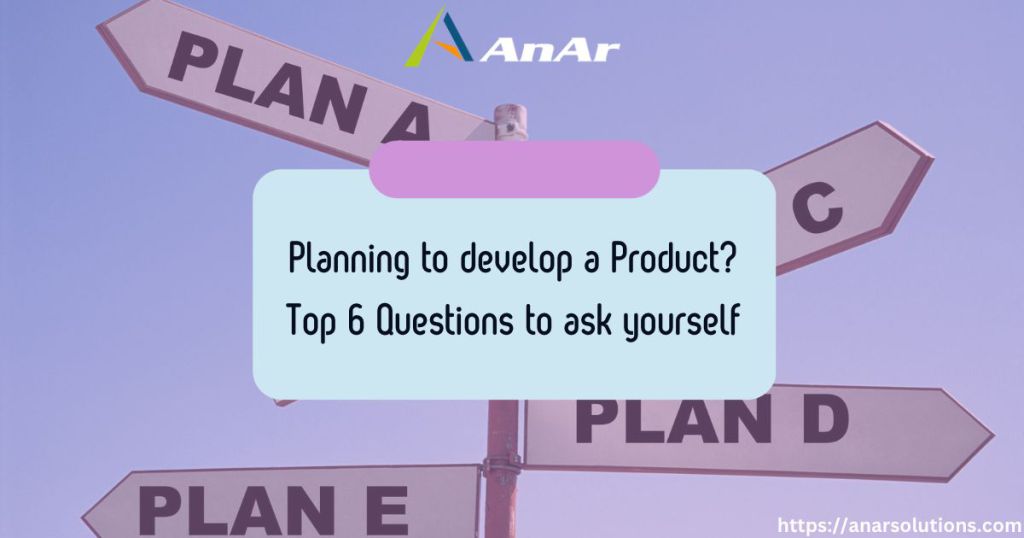The significance of product development and Product Development Planning cannot be taken for granted.
Introducing innovative products to the market creates new opportunities for yourself or your organization and helps you expand business footprints in multiple verticals; hence, launching new products becomes one of the most critical aspects of your strategy.
However, developing new products also involves a significant investment of resources and carries the risk of failure. It is essential for businesses or entrepreneurs to create effective product development plans and carefully allocate their budget and resources to minimize the risk of failure and maximize the chances of success.
Before you start developing your next product development roadmap, consider asking yourself these six questions so that you can launch and market a successful product without wasting your valuable resources in the wrong direction.
Top 6 Questions to ask yourself – when planning a new product development

Who needs to be a part of the product development process?
When working on a new product development project, it is vital to assemble a team with the necessary skills and expertise to ensure the project’s success. The team should be composed of individuals with the required knowledge, experience, and training to perform the tasks needed to develop the product.
It is essential to consider the following elements when assembling the team:
- Identify the key roles that need to be filled and the specific skills and experience required for each position.
- Identify who should be involved in the project and how much input will be required from each person.
- Clearly defined roles and responsibilities of all project team members.
- Ensure that effective communication channels and a clear plan for sharing information among team members are established.
A well-defined team with the appropriate individuals involved in the product development process is crucial for product development planning. Clear roles and responsibilities, effective communication, and a shared vision for the product will all contribute to a smooth and successful product development process. Establishing these elements before proceeding with the project is crucial to ensure that the team can work effectively together to achieve the project’s objectives.
Who is our target demographic & market?
Understanding your target audience is also crucial for a successful product development planning and better go-to-marketing strategy. By identifying key elements of your target market, you can create a more effective strategy for reaching and engaging with them. Here are some important facts to consider when researching your target audience:
- Demographics: Who are your target customers? Consider factors such as age, race, gender, career, education level, and income.
- Buying process: How do your target customers make purchasing decisions? Are they more likely to read reviews or purchase through social media apps? Understanding their buying habits can help you create a more effective marketing strategy.
- Communication preferences: What channels do your target customers prefer to use when communicating with businesses? Are they more likely to use email, social media, or texting? Knowing this information can help you determine where to focus your marketing efforts.
- Priorities and personal values: What are your target customers’ priorities and values? Understanding what they value can help you create a message that resonates with them.
- Problems: What problems do your target customers deal with, and how does your product solve them? Identifying the problems your product addresses can help you create messaging that highlights the benefits of your product.
With this information, you can develop a more detailed marketing strategy and even find ways to improve your product based on your buyer persona research.
What kind of solution does this product offer, and how effective is this solution?
Doing a comprehensive target market research is Also a crucial part of Product Development Planning, it is important to identify the problems faced by your audience and how your product can address these issues. It is essential to ensure that your product provides a straightforward solution to the consumer’s problem. If there are other similar products on the market, consider what makes your product unique or how it stands out from the competition.
While developing your new product development plan; conducting clinical studies or customer surveys can be beneficial in demonstrating the effectiveness of a product or service, especially if it is new to the market. This research will help to communicate the value of your product to potential customers in effective manner. For instance, e-commerce food delivery companies like Zomato, DoorDash, and UberEats use customer reviews and satisfaction data to promote their homepage’s best-selling, most popular, and trending items.
Have we thoroughly considered the risks associated with new product development?
Product development Planning is a critical aspect of any business as it holds significant growth and expansion potential. However, it is essential to remember that a certain level of risk comes with new product development. Before developing a new product, it is essential to consider the potential risks and weigh them against the potential benefits. Evaluating the potential risks and measuring the impact on the company is crucial in making informed decisions about developing new products.
One of the first steps in assessing the potential risks of new product development is to have a comprehensive plan in place. This plan should outline the specific scenarios and the risk-reward ratio. It should also include a thorough analysis of the market, competition, and consumer demand to ensure that the new product will be viable in the market. Additionally, it is important to consider the resources required for developing and launching the new product and how it will be provisioned.
Ultimately, the decision to proceed with new product development will depend on the specific scenario and the risk-reward ratio. By taking a strategic and calculated approach to new product development, companies can effectively balance growth and risk to achieve long-term success.
Have we worked on a detailed brand strategy?
While creating your product development plan, branding becomes an essential component of marketing and helps establish a solid and recognizable image for a business. Catchphrases like “Just Do It” and iconic logos like the silhouette of an apple are examples of effective branding. This step is particularly important for new products that lack a history of positive reviews and purchases. Creating a solid brand can be a crucial differentiator in the market and attract potential customers.
A brand guide is an excellent starting point for creating a solid brand identity. It should include the following elements:
- Mission statement/brand vision: A clear and concise statement that outlines the company’s purpose and goals.
- Description of the target audience: A detailed understanding of the target audience’s demographics, values, and needs.
- Brand values: The core values that the company stands for and wants to communicate to its audience.
- Brand story: A narrative that explains the company’s history, vision, and mission.
- Taglines and messaging guidelines: A set of guidelines that define the tone of voice and messaging to be used across all communication channels.
- Logo usage: Guidelines for using the company’s logo, including color variations, placement, and size.
- Color palette: A set of colors used consistently across all branding materials.
- Typeface: Guidelines for the typeface
If you need inspiration for your brand, it is worth looking at Zendesk’s brand guidelines, which they have creatively named “Brandland.” From my perspective, this brand guideline is one of the most comprehensive and well-designed out there. Zendesk has exceptionally created a consistent and recognizable brand image that stands out in the market. From the overall appearance of products to the typography and color palette, Zendesk has a cohesive and polished look that sets it apart from other companies in the industry.
What are our plans for promoting the product launch?
Promotions usually comes last on the product development planning process, your new product is a crucial aspect of the launch process, regardless of whether your brand is well-established or just starting out. The methods used to spread the word will depend on the current status of your brand.
- For established brands with an existing audience, email campaigns, social media, and in-store promotions can effectively reach out to customers and followers. These methods allow for direct communication with your audience and can be easily tailored to fit your brand’s messaging and goals.
- For emerging brands, building a following can be more challenging. Targeted ads, SEO, events, and affiliate marketing partnerships are some initial tactics that can be considered to help increase brand awareness and reach a new audience. These methods can be a great way to get your brand noticed in front of potential customers and generate interest in your new product.
- Creating a calendar for all your campaign initiatives is essential to ensure that your product launch campaign stays organized and on track. This calendar can include emails, social posts, and events and help you keep track of all of the different elements of your campaign, ensuring that everything runs smoothly.
Final Wrap-up
In conclusion, launching a new product is an exciting and vital step for any business. But before you release your new product to the market, it’s essential to take the time to plan and execute your launch strategy. Remember, proper planning and execution are critical to a successful product launch, so take the time to carefully consider each step before you release your product to the world. Asking yourself these six questions can help you identify potential risks and opportunities and ensure your product launch is as successful as possible.





